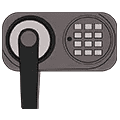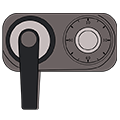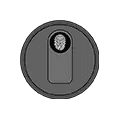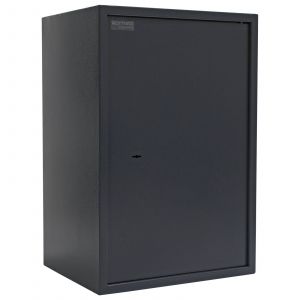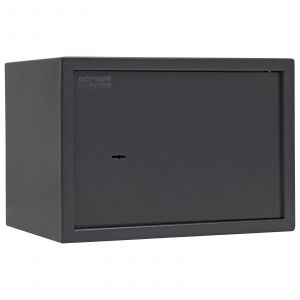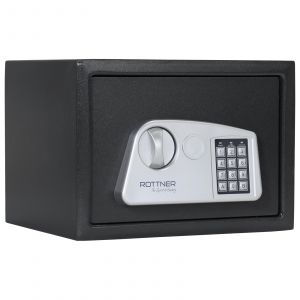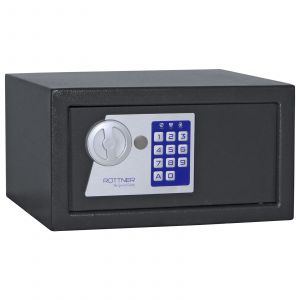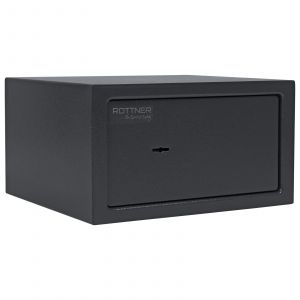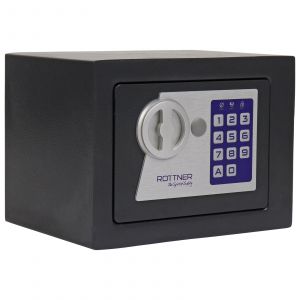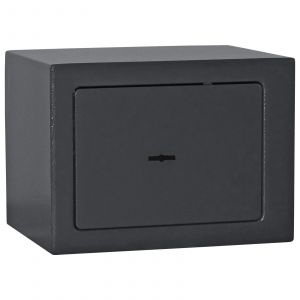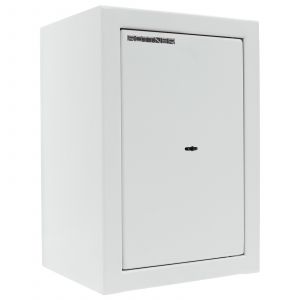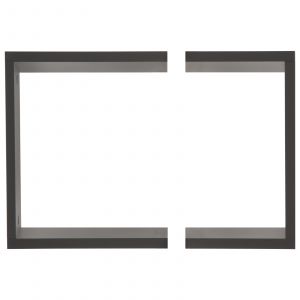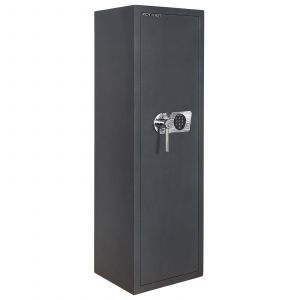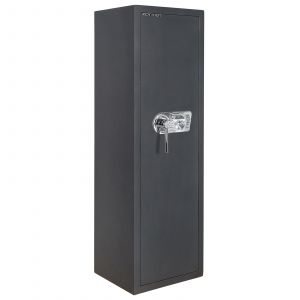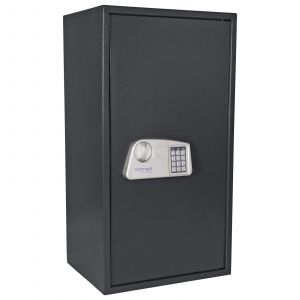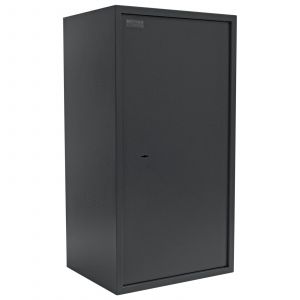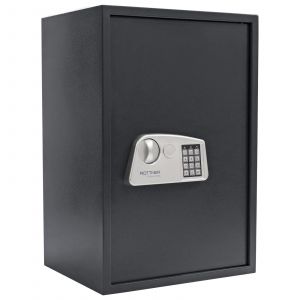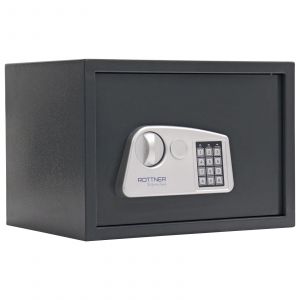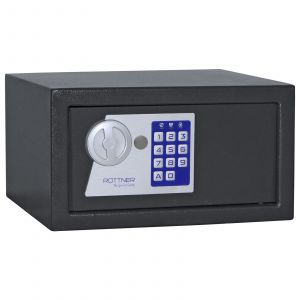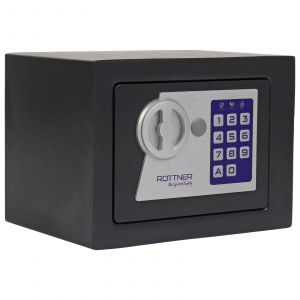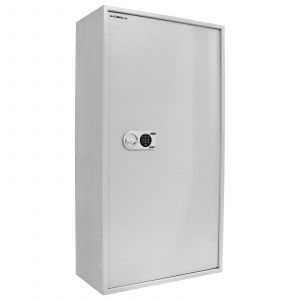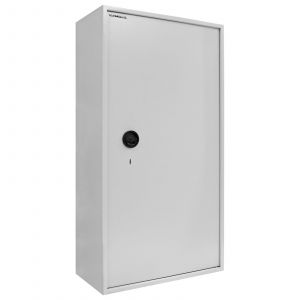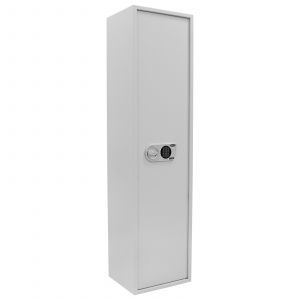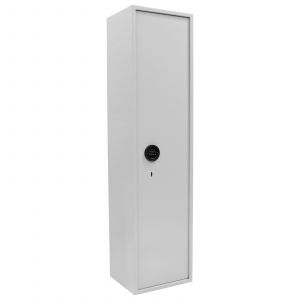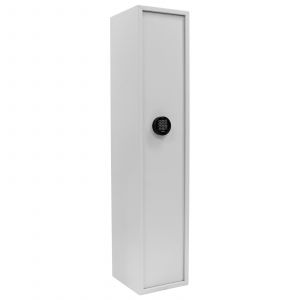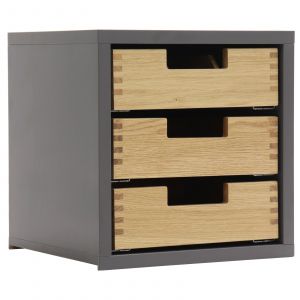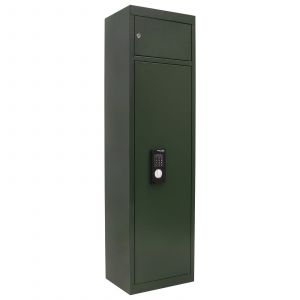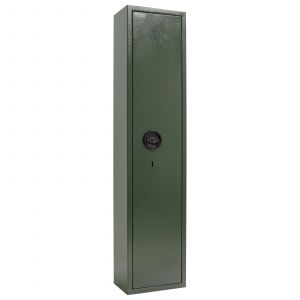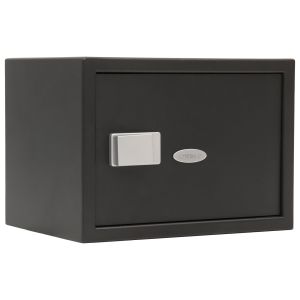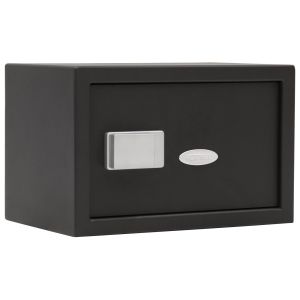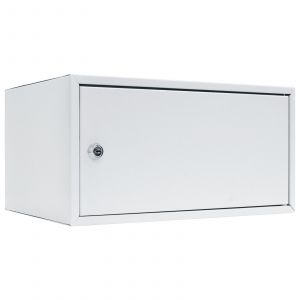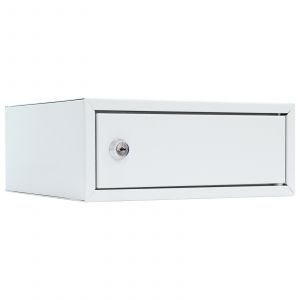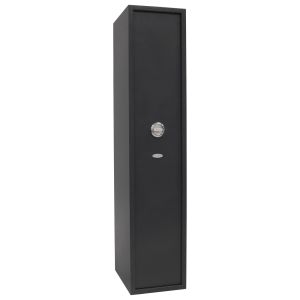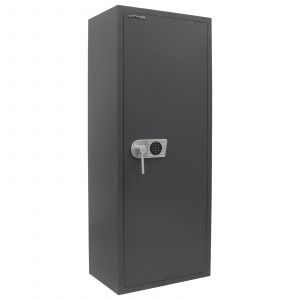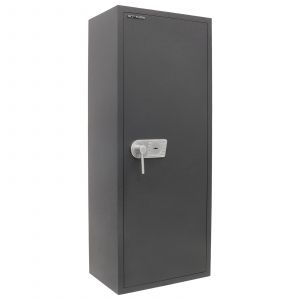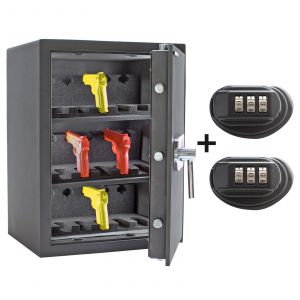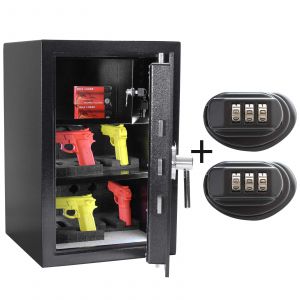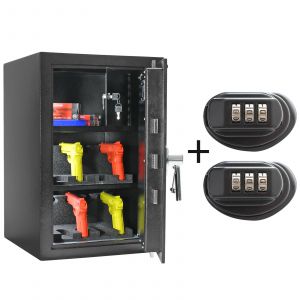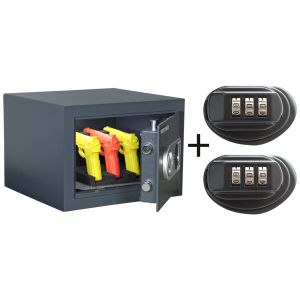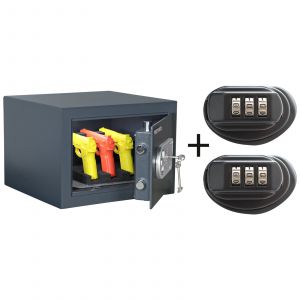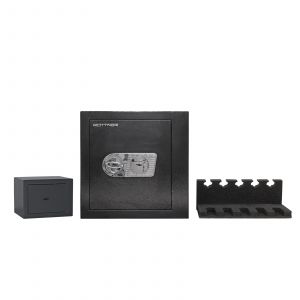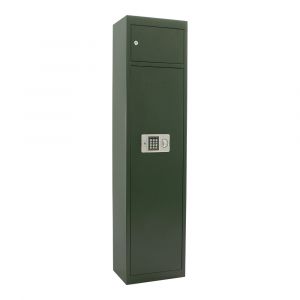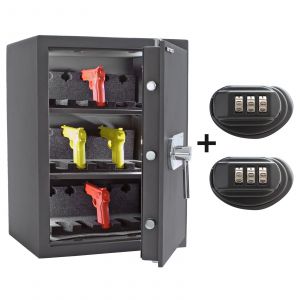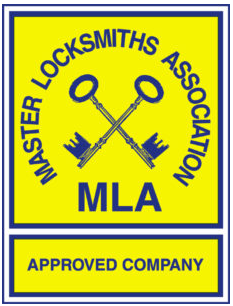BUY GUN CABINETS
The Rottner gun safes can usually hold 5 to 10 long shotguns. The tested Waidmann range with its 8 different sizes can hold up to 18 guns. Some sizes are also available on order, with a longer lead time.
For better protection, we also offer burglar-proof and certified weapon safes. These safes are certified and tested for burglary resistance according to European Standardization ECBS-S. (EN14450 or EN 1143-1 standard)
Please contact us for stock inquiries. Gun safes, as required by law, also have an internal lockable safe for separate storage of ammunition. Newest addition to the Rottner Gun Cabinets range is the UK tested Guardian gun safe, to hold 3 shotguns, and with double EN 1300 class A key lock.
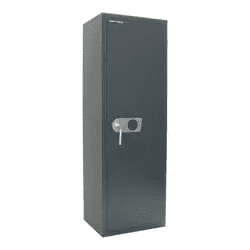
- Rottner Furniture Safe Jupiter 5 Key Lock
- Safety class Without security level
- Outer dimension (mm) Height x Width x Depth 670 x 450 x 360
- Lock Type Double-bit lock (incl. 2 keys)
- Weight KG 25
£251.70incl. VAT & free shippingImmediately available, delivery time 1-3 working days - Rottner Furniture Safe Jupiter 4 Key Lock
- Safety class Without security level
- Outer dimension (mm) Height x Width x Depth 300 x 430 x 320
- Lock Type Double-bit lock (incl. 2 keys)
- Weight KG 11
£138.30incl. VAT & free shippingImmediately available, delivery time 1-3 working days - Rottner Furniture Safe Jupiter 3 Electronic Lock
- Safety class Without security level
- Outer dimension (mm) Height x Width x Depth 250 x 350 x 280
- Lock Type Electronic lock
- Weight KG 8.5
£109.50incl. VAT & free shippingImmediately available, delivery time 1-3 working days - Rottner Furniture Safe Jupiter 2 Electronic Lock
- Safety class Without security level
- Outer dimension (mm) Height x Width x Depth 170 x 310 x 280
- Lock Type Electronic lock
- Weight KG 5
£90.00incl. VAT & free shippingImmediately available, delivery time 1-3 working days - Rottner Furniture Safe Jupiter 2 Key Lock
- Safety class Without security level
- Outer dimension (mm) Height x Width x Depth 170 x 310 x 280
- Lock Type Double-bit lock (incl. 2 keys)
- Weight KG 5.5
£66.70incl. VAT & free shippingImmediately available, delivery time 1-3 working days - Rottner Furniture Safe Jupiter 1 Electronic Lock
- Safety class Without security level
- Outer dimension (mm) Height x Width x Depth 170 x 230 x 170
- Lock Type Electronic lock
- Weight KG 2.5
£64.90incl. VAT & free shippingImmediately available, delivery time 1-3 working days - Rottner Furniture Safe Jupiter 1 Key Lock
- Safety class Without security level
- Outer dimension (mm) Height x Width x Depth 170 x 230 x 170
- Lock Type Double-bit lock (incl. 2 keys)
- Weight KG 2.5
£57.80incl. VAT & free shippingImmediately available, delivery time 1-3 working days - Rottner Handgun Safe Yukon 40 S1Key Lock Light Grey
- Number handguns 4
- Safety class Class S1
- Outer dimension (mm) Height x Width x Depth 400 x 280 x 230
- Lock Type Double-bit lock (incl. 2 keys)
- Weight KG 14
£358.00incl. VAT & free shipping14 - 18 weeks delivery time - Rottner Side Parts Wooden Insert Extension Uni
- Outer dimension (mm) Height x Width x Depth 365 x 540 x 285
- Weight KG 0.62
£140.00incl. VAT & free shipping8 - 10 Weeks Delivery Time - Rottner Weapon Cabinet Dakota Basic EN0 Electronic Lock Anthracite
- Number Weapons 5
- Number handguns 5
- Safety class Class EN 0
- Outer dimension (mm) Height x Width x Depth 1275 x 390 x 320
- Lock Type Electronic lock
- Weight KG 90
£1,167.00incl. VAT & free shipping14 - 18 weeks delivery time - Rottner Weapon Cabinet Dakota Basic DB EN0 Key Lock Anthracite
- Number Weapons 5
- Number handguns 5
- Safety class Class EN 0
- Outer dimension (mm) Height x Width x Depth 1275 x 390 x 320
- Lock Type Double-bit lock (incl. 2 keys)
- Weight KG 90
£1,082.00incl. VAT & free shipping14 - 18 weeks delivery time - Rottner Furniture Safe Jupiter 6 Electronic Lock
- Safety class Without security level
- Outer dimension (mm) Height x Width x Depth 850 x 450 x 360
- Lock Type Electronic lock
- Weight KG 30
£459.00incl. VAT & free shipping14 - 18 weeks delivery time - Rottner Furniture Safe Jupiter 6 Key Lock
- Safety class Without security level
- Outer dimension (mm) Height x Width x Depth 850 x 450 x 360
- Lock Type Double-bit lock (incl. 2 keys)
- Weight KG 30
£434.00incl. VAT & free shipping14 - 18 weeks delivery time - Rottner Furniture Safe Jupiter 5 Electronic Lock
- Safety class Without security level
- Outer dimension (mm) Height x Width x Depth 670 x 450 x 360
- Lock Type Electronic lock
- Weight KG 25
£259.60incl. VAT & free shippingImmediately available, delivery time 1-3 working days - Rottner Furniture Safe Jupiter 4 Electronic Lock
- Safety class Without security level
- Outer dimension (mm) Height x Width x Depth 300 x 430 x 320
- Lock Type Electronic lock
- Weight KG 11
£145.90incl. VAT & free shippingImmediately available, delivery time 1-3 working days - Rottner Furniture Safe Jupiter 2 Key Alike Electronic Lock Anthracite
- Safety class Without security level
- Outer dimension (mm) Height x Width x Depth 170 x 310 x 280
- Lock Type Electronic lock
- Weight KG 5
£128.00incl. VAT & free shipping14 - 18 weeks delivery time - Rottner Furniture Safe Jupiter 1 Key Alike Electronic Lock Anthracite
- Safety class Without security level
- Outer dimension (mm) Height x Width x Depth 170 x 230 x 170
- Lock Type Electronic lock
- Weight KG 2.5
£91.00incl. VAT & free shipping8 - 10 Weeks Delivery Time - Rottner Ammunition and Gun Cabinet Yukon 14 S1Electronic Lock Light Grey
- Number Weapons 14
- Safety class Class S1
- Outer dimension (mm) Height x Width x Depth 1500 x 800 x 400
- Lock Type Electronic lock
- Weight KG 105
£1,531.00incl. VAT & free shipping14 - 18 weeks delivery time - Rottner Ammunition and Gun Cabinet Yukon 14 S1 Key Lock Light Grey
- Number Weapons 14
- Safety class Class S1
- Outer dimension (mm) Height x Width x Depth 1500 x 800 x 400
- Lock Type Double-bit lock (incl. 2 keys)
- Weight KG 105
£1,411.00incl. VAT & free shipping8 - 10 Weeks Delivery Time - Rottner Ammunition and Gun Cabinet Yukon 8 S1 Electronic Lock Light Grey
- Number Weapons 8
- Safety class Class S1
- Outer dimension (mm) Height x Width x Depth 1600 x 400 x 340
- Lock Type Electronic lock
- Weight KG 63
£1,007.00incl. VAT & free shipping8 - 10 Weeks Delivery Time - Rottner Ammunition and Gun Cabinet Yukon 8 S1 Key Lock Light Grey
- Number Weapons 8
- Safety class Class S1
- Outer dimension (mm) Height x Width x Depth 1600 x 400 x 340
- Lock Type Double-bit lock (incl. 2 keys)
- Weight KG 63
£850.00incl. VAT & free shipping14 - 18 weeks delivery time - Rottner Ammunition and Gun Cabinet Yukon 5 S1 Electronic Lock Light Grey
- Number Weapons 5
- Safety class Class S1
- Outer dimension (mm) Height x Width x Depth 1450 x 300 x 340
- Lock Type Electronic lock
- Weight KG 47
£760.00incl. VAT & free shipping14 - 18 weeks delivery time - Rottner Wooden Insert with 3 Drawers for Safes
- Outer dimension (mm) Height x Width x Depth 325 x 320 x 295
- Weight KG 12
£834.00incl. VAT & free shipping8 - 10 Weeks Delivery Time - Rottner Weapon Cabinet Utah 8 Electronic Lock Green
- Number Weapons 8
- Safety class Without security level
- Outer dimension (mm) Height x Width x Depth 1450 x 400 x 300
- Lock Type Electronic lock
- Weight KG 28
£473.00incl. VAT & free shipping8 - 10 Weeks Delivery Time - Rottner Gun Cabinet Colorado 3 Key Lock
- Number Weapons 3
- Safety class Without security level
- Outer dimension (mm) Height x Width x Depth 1380 x 315 x 205
- Lock Type Double-bit lock (incl. 2 keys)
- Weight KG 28
£406.00incl. VAT & free shipping14 - 18 weeks delivery time - Rottner Furniture Safe FIFTY BT Safe 2 Anthracite
- Safety class Without security level
- Outer dimension (mm) Height x Width x Depth 250 x 350 x 250
- Lock Type Handy Öffnung
- Weight KG 10.5
£251.00incl. VAT & free shipping14 - 18 weeks delivery time - Rottner Furniture Safe FIFTY BT 1 Anthracite
- Safety class Without security level
- Outer dimension (mm) Height x Width x Depth 200 x 310 x 200
- Lock Type Handy Öffnung
- Weight KG 8
£248.00incl. VAT & free shipping14 - 18 weeks delivery time - Rottner Security Compartment Home Case 3 Light Gray
- Safety class Without security level
- Outer dimension (mm) Height x Width x Depth 190 x 370 x 260
- Lock Type Cylinder lock with 2 keys
- Weight KG 5.3
£83.80incl. VAT & free shippingImmediately available, delivery time 1-3 working days - Rottner Security Compartment Home Case 1 Light Gray
- Safety class Without security level
- Outer dimension (mm) Height x Width x Depth 100 x 250 x 230
- Lock Type Cylinder lock with 2 keys
- Weight KG 2.3
£60.00incl. VAT & free shipping8 - 10 Weeks Delivery Time - Rottner Gun Safe Fifty BT Gun Anthracite with Bluetooth Lock
- Number Weapons 5
- Safety class Without security level
- Outer dimension (mm) Height x Width x Depth 1450 x 300 x 400
- Lock Type Handy Öffnung
- Weight KG 48
£641.00incl. VAT & free shipping14 - 18 weeks delivery time - Rottner Ammunition and Gun Cabinet Winchester 10 EN0 Electronic Lock Anthracite
- Number Weapons 10
- Number handguns 5
- Safety class Class EN 0
- Outer dimension (mm) Height x Width x Depth 1500 x 600 x 400
- Lock Type Electronic lock
- Weight KG 154.5
£1,816.00incl. VAT & free shipping10 - 14 weeks delivery time - Rottner Ammunition and Gun Cabinet Winchester 10 EN0 Key Lock Anthracite
- Number Weapons 10
- Number handguns 5
- Safety class Class EN 0
- Outer dimension (mm) Height x Width x Depth 1500 x 600 x 400
- Lock Type Double-bit lock (incl. 2 keys)
- Weight KG 154.5
£1,709.00incl. VAT & free shipping14 - 18 weeks delivery time - Rottner Handgun Safe KWT-65 EN-1 Electronic Lock Anthracite
- Safety class Class EN 1
- Outer dimension (mm) Height x Width x Depth 660 x 490 x 410
- Lock Type Electronic lock
- Weight KG 82
£1,386.00incl. VAT & free shipping14 - 18 weeks delivery time - Rottner Handgun Safe KWT-65 EN-1 Electronic Lock črn
- Safety class Class EN 1
- Outer dimension (mm) Height x Width x Depth 655 x 435 x 445
- Lock Type Electronic lock
- Weight KG 83
£1,312.00incl. VAT & free shipping1 -2 Weeks Delivery Time - Rottner Handgun Safe KWT-65 EN-1 Key Lock Anthracite
- Safety class Class EN 1
- Outer dimension (mm) Height x Width x Depth 655 x 435 x 445
- Lock Type Double-bit lock (incl. 2 keys)
- Weight KG 83
£1,079.00incl. VAT & free shipping8 - 10 Weeks Delivery Time - Rottner Handgun Safe KWT-40EL-EN-0 Electronic Lock Anthracite
- Number handguns 5
- Safety class Class EN 0
- Outer dimension (mm) Height x Width x Depth 300 x 420 x 390
- Lock Type Electronic lock
- Weight KG 35
£883.00incl. VAT & free shipping14 - 18 weeks delivery time - Rottner Handgun Safe KWT-40-EN-0 Key Lock Anthracite
- Number handguns 5
- Safety class Class EN 0
- Outer dimension (mm) Height x Width x Depth 300 x 420 x 390
- Lock Type Double-bit lock (incl. 2 keys)
- Weight KG 35
£653.00incl. VAT & free shipping8 - 10 Weeks Delivery Time - Rottner Ammunition and Short Weapon Safe Tank EN1 Key Lock
- Safety class Class EN 1
- Outer dimension (mm) Height x Width x Depth 435 x 435 x 445
- Lock Type Double-bit lock (incl. 2 keys)
- Weight KG 61
£825.00incl. VAT & free shippingImmediately available, delivery time 1-3 working days - Rottner Weapon Cabinet Home Star Gun Safe 5 Electronic Lock Green
- Number Weapons 5
- Safety class Without security level
- Outer dimension (mm) Height x Width x Depth 1500 x 370 x 265
- Lock Type Electronic lock
- Weight KG 15
£330.00incl. VAT & free shipping14 - 18 weeks delivery time - Rottner Handgun Safe KWT-65 EN-1 Key Lock Anthracite
- Safety class Class EN 1
- Outer dimension (mm) Height x Width x Depth 660 x 490 x 410
- Lock Type Double-bit lock (incl. 2 keys)
- Weight KG 82
£1,166.00incl. VAT & free shipping14 - 18 weeks delivery time


